We had the chance to try out the brand new Fujifilm XF 18mm F1.4 lens for a few days – here are our detailed first impressions.
The new XF 18mm F1.4 is the 39th Fujifilm X-series lens to be released in the 9 years since the system was first announced, and it joins the 16mm, 23mm and 35mm fast F1.4 prime lenses.
It offers the popular 35mm equivalent focal length of 28mm (well, 27mm to be exact, but who’s counting that 1mm?), making it a classic landscape and street photography prime lens.
Fujifilm already have a 27mm lens in diminutive shape of the XF 18mm F2, which was actually one of the very first lenses that Fuji released back in 2012 along with the X-Pro 1 camera body.
The F2 18mm lens is much more compact, lighter and less expensive than this new F1.4 version, but it has a slower maximum aperture, poorer optical image quality, inferior weather-resistance and more sluggish autofocusing.
Note that the new F1.4 lens doesn’t actually replace the older F2 version – you’ll still be able to buy that lens if you prefer its compactness and more affordable price-tag.
We had the chance to try out the Fujifilm XF 18mm F1.4 for a few days, so without further ado, here are our detailed first impressions.
You can also check out our Fujifilm XF 18mm F1.4 R LM WR Sample Photos, Fujifilm XF 18mm F1.4 R LM WR Hands-on Photos and Fujifilm XF 18mm F1.4 vs XF 18mm F2 – Head to Head Comparison
Size and Weight
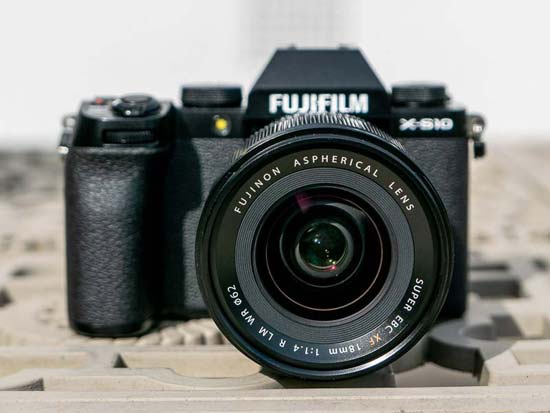
The XF 18mm F1.4 is a much larger lens than the 18mm F2, but it’s still relatively small and light enough to feel well-balanced even on the X-S10 that we tested it with, which is one of the smaller X-series camera bodies.
Weighing 370g and measuring 68.8mm x 75.6mm with a reasonable 62mm filter size, the new 18mm is very similar to the 16mm, 23mm and 35mm lenses – together they would make a great set of F1.4 primes, although some people may prefer just having the 16mm and not bothering with the 18mm, or vice versa.
Optical Construction
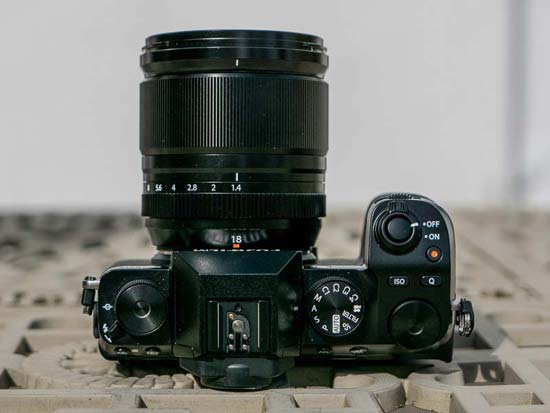
Being a fast lens, the Fuji 18mm F1.4 has a pretty complicated optical construction, being comprised of 15 elements in 9 groups including 3 aspherical and 1 ED elements.
As the lens that we were sent for testing was a pre-production sample, we’re not allowed to comment on the image quality at 100% pixel-peeping level just yet.
Aperture Ring

This lens has a physical aperture ring, just like the majority of other Fujifilm lenses.
The aperture range runs from the maximum value of f1.4/f2 in 1/3-stop increments to f/16, with an Auto setting available if you prefer to set the aperture via the camera body.
The aperture ring on the new F1.4 has a much smoother action than the older F2 version and is much more like the majority of other X-series lenses.
The XF 18mm F1.4 also benefits from having an A (Auto) Position Lock which locks the aperture ring into the A position, preventing any unwanted accidental movement.
Autofocusing
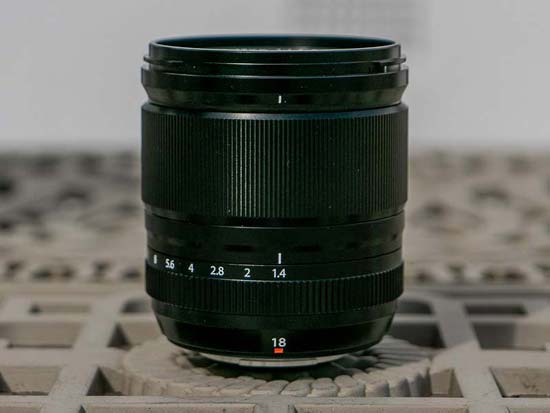
The XF 18mm F1.4 has an internal AF system that’s driven by a powerful linear motor, which resulted in fast, accurate, and virtually silent auto-focusing on the X-S10 camera that we tested it with. You certainly won’t miss many shots when using the AF on this lens.
When used side-by-side with the old 18mm F2 lens, you can really notice the difference – the new one is faster, quieter and less prone to hunting in low-light than the old one.
Manual Focusing
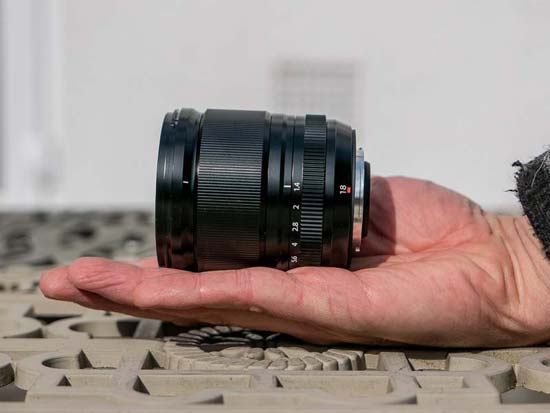
The Fuji 18mm F1.4 has a smooth manual focusing ring that is focus-by-wire, rather than using a mechanical clutch-based focus ring, but that’s also true of every other Fuji X-series lens.
The focus ring on the 18mm F1.4 does at least have a nice feel as the components in the manual focusing ring assembly have been specially engineered to respond with more precision, especially when the focusing ring is moved slightly.
No Manual Focus Clutch?

We’re not really sure why, but for some reason Fujifilm have decided not to include the manual focus collar/clutch that’s on the 16mm and 23mm F1.4 lenses (but not on the 35mm lens).
On those two F1.4 primes, when the focusing ring is pushed forward, the lens is locked into autofocus mode. When the focusing ring is pulled back, the focusing distance scale with depth-of-field markings is revealed and you can manually focus with the lens – very neat.
It would have been great to have seen this feature included on the new Fuji 18mm F1.4 – it’s a real shame that it’s missing.
Build Quality and Weather Resistance
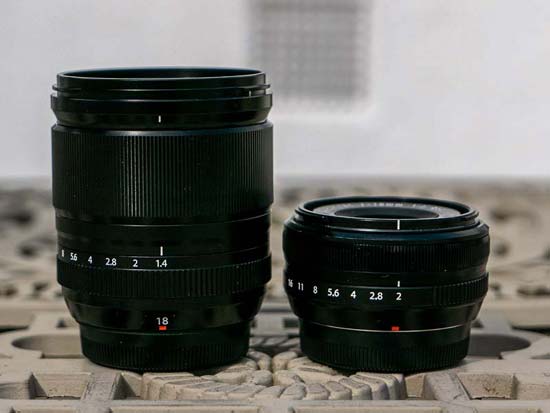
As you’d expect given the high price tag, the Fujifilm 18mm F1.4 has excellent build quality, with a lens barrel that is made from metal, rather than plastic.
As the “WR” abbreviation in the product name denotes, the new 18mm is also fully weather-resistant thanks to seals at eight locations along the lens barrel, making it resistant to dust, moisture, and temperatures as low as -10°C (14°F).
Filter Size
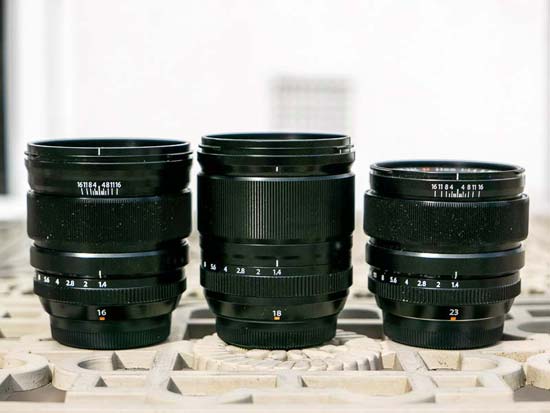
Despite its fast maximum aperture, the Fuji 18mm F1.4 uses 62mm filters, which is a pretty common filter size that won’t break the bank.
Minimum Focusing Distance and Maximum Magnification
The new XF 18mm F1.4 can usefully focus on a subject that is just 20cm away from the camera’s sensor, and the maximum magnification is 0.15x.
Bokeh

The new XF 18mm F1.4 has 9 rounded aperture blades. Coupled with the faster maximum aperture, this means that it’s pretty easy to completely blur the background with the 18mm F1.4, and it also produces appealing bokeh effects too for what is after all a 28mm wide-angle lens.
Price
In the UK the Fujifilm XF 18mm F1.4 costs £879 / $999 in the UK and the US, respectively, which is similar to the 16mm and 23mm F1.4 lenses.
Conclusion
The new XF 18mm F1.4 is a high-quality, fast F1.4 prime from Fujifilm that fills another hole in the X-series lens range.
It’s a real shame that it doesn’t have the manual focus collar from the 16mm and 23mm F1.4, but otherwise it certainly hits the mark in terms of being a small, compact yet high-quality lens that at first look delivers the usual excellent image quality that we’ve grown used to from Fuji lenses.
So what do you think? Are you excited by the new Fuji XF 18mm F1.4 lens? Leave a comment below!
Image Gallery
Click on a thumbnail to see the full version.








